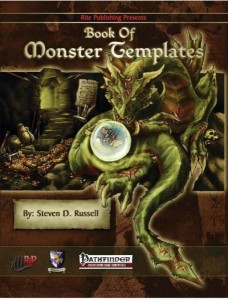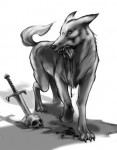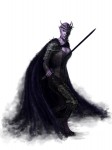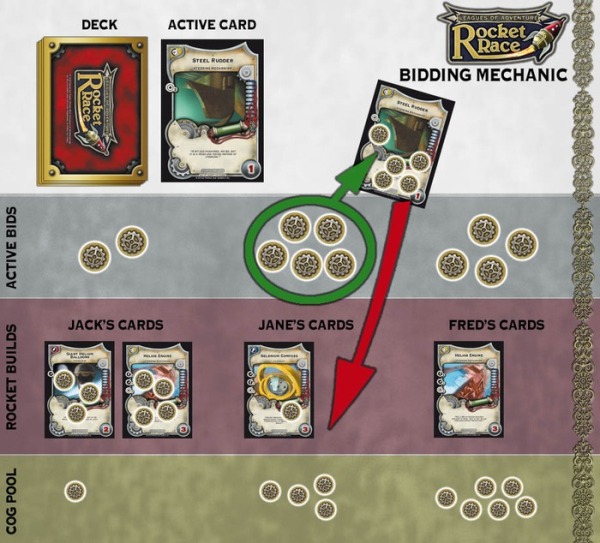Book of Monster Templates
Book of Monster Templates is a supplement for the Pathfinder Roleplaying Game published by Rite Publishing.
By Steven D. Russell

Welcome to the eighth Designer’s Diary, a regular column where designers are given the opportunity to take readers on an in-depth ride through the design and development process of their system, setting, or product.
Designer’s Description
Book of Monster Templates (PFRPG) is exactly what it says on the cover. As a writer I like evocative names, as a designer I want to know exactly what a book does from the title. An RPG is first and formost a game for having continuous fun, so the design needs to win out over story in my humble opinion when it comes to supplmenets like BoMT and adventures should be the products with evocative story names. So within you wil find 30 + new and original monster templates ranging from the accursed creature that cripples a creature reducing its CR in half to the tax collector creature, the spirit of a murdered and much maligned collector of taxes. This also reflects a goal I had for the book, for them to be completely original works, not simply updates, conversion or simply my take on an old idea. These were to be new.
Purpose
I was ready to design a monster book and I noticed even with my own library containing every 3.0 and 3.5 monster book in print and PDF, I still used the same core group monsters in my games and often was simply making changes to existing monsters or putting templates on them far more than I was digging out, or using, other monster books. I also noticed that players had a more visceral reaction to templated monsters. They are more wary of a templated creature than new monsters. There is nothing they can do about the unknown, but giving them something that is hauntingly familiar often upset my group’s PCs far more often.
I also felt it would really fill a niche that the other third party publishers had not touched on yet.

Influences
Mechanically Green Ronin’s Advanced Bestiary by Matthew Sernett is nearly a perfect 5 out of 5 stars book of templates as one can expect, when it comes to what I use most there is the core monster book and then this book. I knew my page count limit would not let me go this big but I wanted it to be my love letter to that book but designed for the Pathfinder Roleplaying Game. Another smaller influence was the Book of Templates Deluxe Edition by Silverthrone/Goodman Games; the Monster Handbook by Mike Mearls for Fantasy Flight Games, The Blackdyrge’s Templates series for 3.5, and The Beast Builder by Expeditious Retreat Press, along with all the templates in the Tome of Horrors I-III and Creature Collections I-III;
Thematically, I always look at taboos, mythology, mortal folly, and then often a bit of cinematic flair when creating monsters. Frankenstein (our games flesh golems) are about the taboo of the desiccation of the dead and playing god by trying to create life through unnatural means. Godzilla is the best example I know of mortal folly, created though the human misuse of atomic weapons with no concern for the consequences. The Cinematic flair is the bit in your game that the player will always remember that needs to go beyond anything the base monster has ever done before. For example the Runecarved creature template used on the dragon that appears on the front cover. Its change in appearance adds this flair, letting the PCs know that this is not the standard dragon they have been fighting since they started playing back in high school.
Research
Oh the research, like I said I own every monster book produced for the d20 system, I spent a lot of time asking on various message board threads to make that list and to find out what books people used the most, and then I spent my time reading the reviews of those books. My goal was to learn not only what made them so great but what little things made them fall short of perfection, so that I could learn from not only their mistakes but from their successes. This research was also done so that I did not duplicate anyone else’s template from the 3.0 or 3.5 eras even by accident.
I also posted on the Paizo compatibility forums every week with the new template I was working on, and getting feedback from potential customers on what they wanted to see. Now as a professional designer (I make my living doing this), you must possess a large ego, thick skin and large amount of persistence, so when your instincts tell you that a customer’s suggestion is bad, you have to know when to ignore it. However, you also need to be able to recognize that your product will be better served by using a customer’s idea not just when it is better than your idea, but also when it is just as valid as your idea.

Art Direction
I never started on a template and its sample creature until I had the art in hand, so I could always be assured that the description of the work would match the image. Some folks might see this as a limitation to their designs but as Troy Denning has said about writing Pages of Pain for the Planescape setting, writing with limitations makes you a better writer. In my opinion, that image should inspire you, not hinder your imagination. The contributing freelancers Ben McFarland, Crystal Fraizier, Jonathan McAnulty, and Michael Welham who did about 10 of the really great pieces in here really understood this and created wonderful designs. We drew our inspiration from Hugo Solis’s amazing cover art, to Rick Hershey’s exceptional interior images, and we even had a few surprises like Jonathan Roberts, who normally serves as our cartographer, came along and gave a fascinating image he had simply been practicing with that turned into the fearmongerer creature template by Michael Welham.
Gaming Experience
There is a good mix here. First is to make old monsters new again with the existing templates, while taking advantage of the years of built in emotional responses PCs have to the core monsters. Then adding some interesting feats that work with the templates or sample creatures so you can apply this to a different monster and get a different experience yet again. Finally is the sample monster, and against all precedent I used new monster and not monsters from the core books to give GMs something truly unique to use against their players.
Comparison
This is actually a very difficult question for me to answer publicly. As a designer you seek to make the best product possible but I don’t want to bash another company’s product. So I am not going to name specific prouduts by name. Some template books frustrate me with split page layouts, we did a perfect job of making the templates fit on a single or double page layout so that you know where a template starts and stops. Another drawback to me was not being able to apply templates quickly, and having to figure out what the ultimate effect on attacks and damage to a creature would be. You can apply the template in less than 10 minutes without having to worry about how many things have a +4 to Dexterity changes in the stat block as it is all listed right there for you. The rare book also fails to have a piece of artwork for each sample monster and I made sure that did not happen with our book. We also dealt with the idea that masters of monster lore would know about this strange creatures, and so we provided Lore for each sample creature. We also did not reinvent the wheel and duplicate another company’s templates.
Where do we fall short? Well if I had to do it over again I would have done more templates, and then done a hardback version.





Just wanted to say thanks for having me.